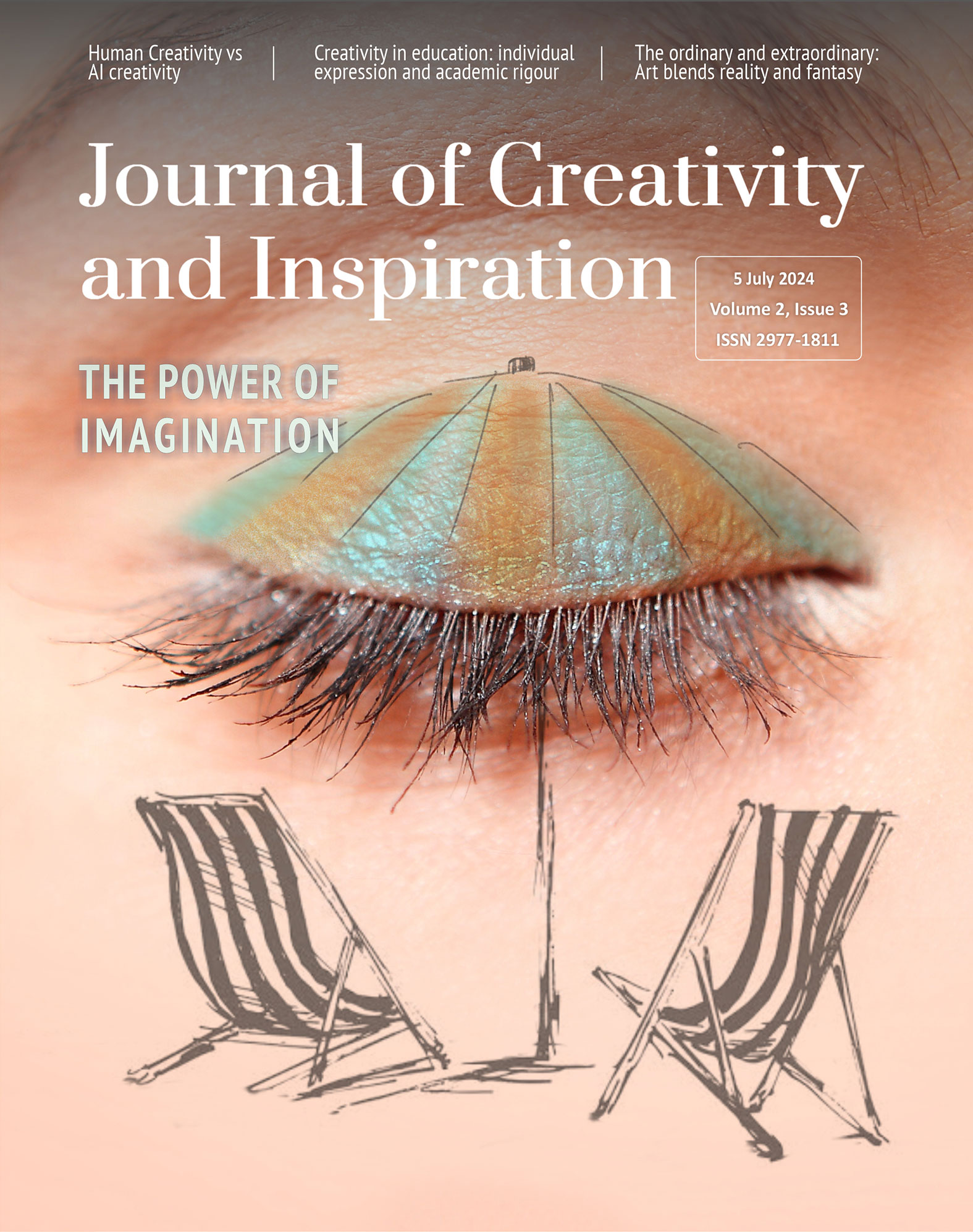The many shades of blue: art, emotion, and spirituality in modern British painting
5 July 2024 – Vol 2, Issue 3.
Blue is a colour considered commonplace in contemporary and modern art, yet it had an intricate ‘introduction’ to the canvas. Originally blue paint was formed from the rock Lapis Lazuli, a stone found in the mountains of northern Afghanistan. The ancient Egyptians mainly used this stone as a component of jewellery. When the stone was ground it would turn into a grey powder. The Egyptians could not figure out how to maintain its bright colour. In art, blue is associated with the heavens and the gods, a sacred colour used sparingly due to its rarity.

Shades of blue.
Lapis Lazuli first appeared as a pigment in 6th-century Buddhist paintings in Bamiyan, Afghanistan. Italian traders in the 14th and 15th centuries brought Lapis Lazuli to Venice, where it became known as ultramarine. Similarly to Egypt, ultramarine was reserved for the most important religious icons.
The colour was revolutionary but very expensive – at points it was more expensive than gold. Subsequently, the paint was used only in aristocratic commissions. The exclusivity of ultramarine elevated the status and prestige of the artworks.
Blue is constantly revisited in cycles throughout art history. For instance, in Picasso’s Blue Period, blue was used to express isolation and melancholy, but later Picasso used blue more pleasantly in his Rose Period. Picasso’s Blue Period depicted themes of poverty, loneliness, despair and sombre through its blue tones, whereas the Rose Period represents more cheerful themes of clowns, harlequins and carnival performers, with his use of blue combined with oranges, pinks and earthy tones, lifting the overall palette.
Blue’s versatility and preciousness make it a constant in art, with varied interpretations. Its cool tones represent calmness and stability, whereas its deeper shades convey introspection and contemplation. Blue has one of the largest varieties of shades, definitions and tones of all colours. Each shade of blue offers a unique emotional palette, allowing artists to explore the full spectrum of human experience.
Blue in Contemporary Art
Blue’s versatility allows it to be a vehicle for various artistic movements and styles. Surrealist artists, for example, have harnessed blue’s dreamlike qualities to create otherworldly scenes. The emotional depth of blue is perhaps its most compelling attribute. Artists have long used blue to convey a range of feelings, from melancholy to joy. As blue can evoke feelings of calmness and tranquillity, it became a popular choice for creating serene and meditative spaces. In art, this translates to compositions that invite viewers to pause and reflect. Blue’s calming presence offers a refuge from the chaos of the world, providing a moment of peace and contemplation.
British Art
When conceptualising the exhibition (‘Modern British Blues: A Selection of Art from The Reiff Collection’) we looked at exploring the colour blue holistically. Blue in nature, such as the sky and the sea, immediately comes to mind. However, blue also embodies emotions, music, and literature. It is not merely a colour; it represents a spectrum of sensations and cultural expressions.
In the work ‘Allegory of Life’ by Margaret Maitland Howard, the use of blue comes through the central angelic figure. For Maitland Howard, blue appears to be a colour associated with spirituality and religion. This interpretation of blue goes beyond the melancholy often linked to Picasso’s work, instead conveying ideas of hope and trust in religion.
Margaret’s works are very neoclassical and Romantic – traditions you would expect to see from the mid to late 19th century. However, she was working in the 20th century, influenced by these bygone traditions. This is unusual for her time, as contemporary movements like Surrealism and Cubism were emerging, yet she chose to stick with realism and Romanticism.
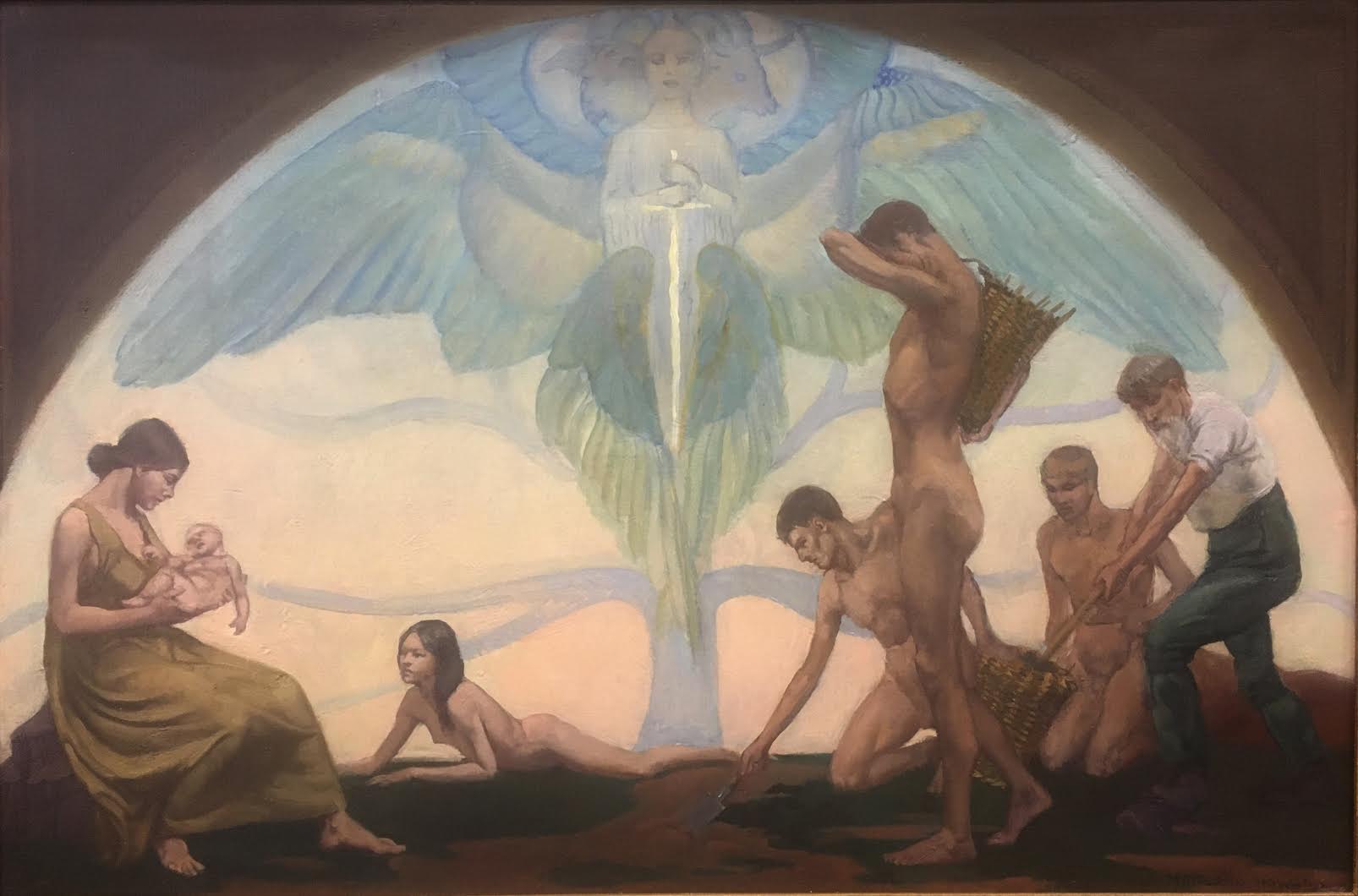
‘Allegory of Life’ by Margaret Maitland Howard (1904-1974). Oil on canvas. 50.7 x 76.1 cm. © The Reiff Collection of Modern British Art.
It can be speculated that the work reflects the biblical story of humanity’s fall from grace after Adam and Eve’s betrayal. The painting illustrates this narrative – on one side, a mother with a child, and on the other, men labouring. One man is depicted in contemporary clothing suggesting the relevance of this theme today. The use of blue in this context emphasises the enduring relevance of ancient stories in modern times.
The movement within the piece is intriguing. The central blue figure with a sword draws the eye, but the surrounding figures all face the mother with a child on the left, creating a cycle of focus. This piece directs the viewer’s attention to the left. The various gazes are directed towards the mother.
So, the use of blue in the spiritual figure draws initial attention, but the composition ultimately centres on the mother and child, reflecting the origins of life, which ties back to the title ‘Allegory of Life’.
In ‘Portrait of a Girl with a Blue Drape’ by Anna Airy, the theme shifts from spirituality to calmness and introspection. The sitter appears distant, controlling her own gaze, which challenges the 19th-century tradition of the ‘male gaze’ where women were objects to be viewed. The blue drape could be seen as a source of power, allowing her to look away, or as a means of hiding. The blue hue extends beyond the drape to her eyes and shoulders, suggesting it is inherent to her being, almost making her glow. This gives a sense of power and spirituality, like a halo. The colour blue becomes a bridge between the physical and the spiritual.
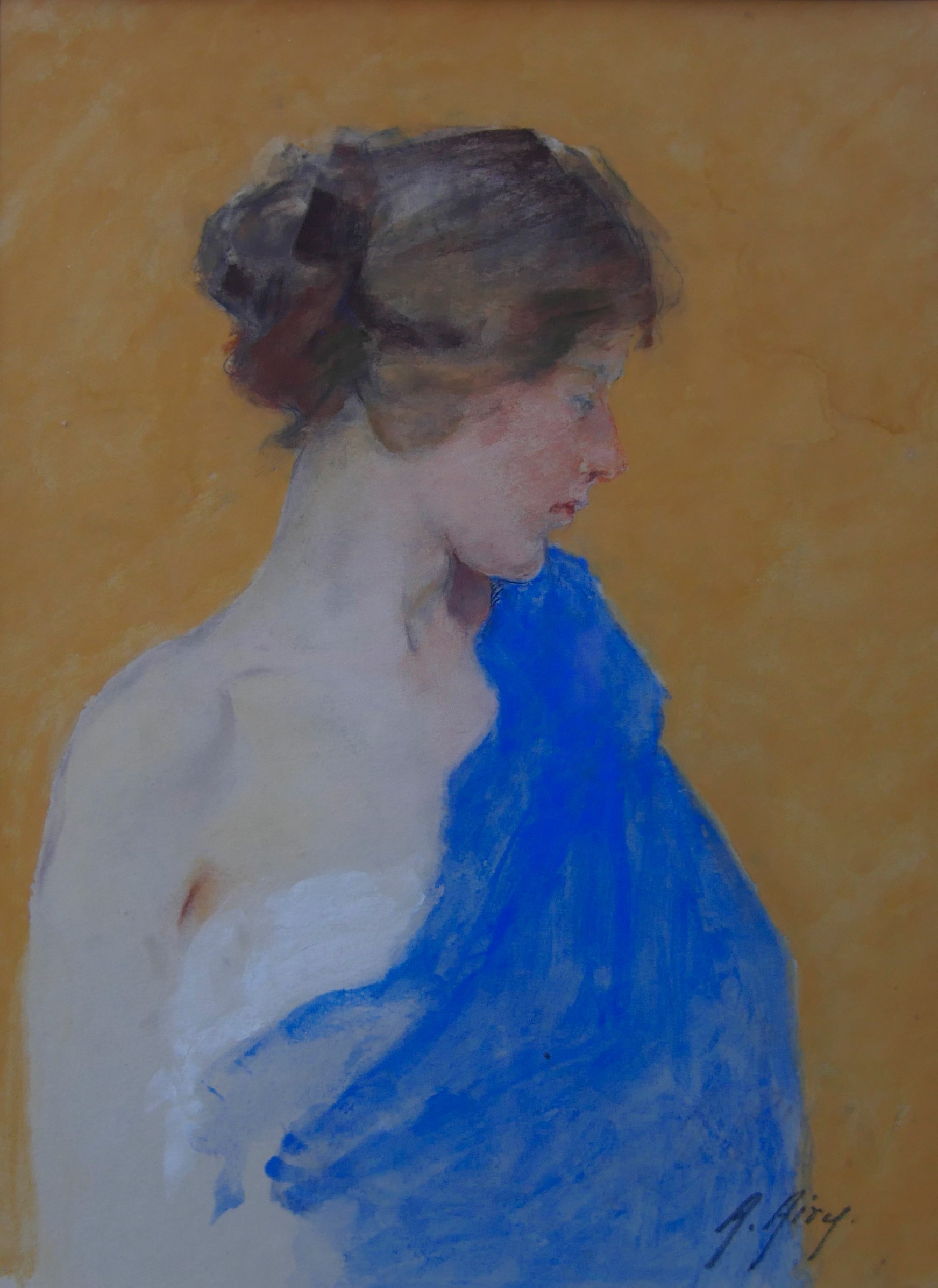
‘Portrait of a Girl with a Blue Drape’ by Anna Airy (1882-1964). Pastel on board. 48.3 x 40 cm. © The Reiff Collection of Modern British Art.
Another piece is ‘Variation on a Theme’ by Carlo Rossi. Rossi, a Scottish painter of Italian descent, appears to express a deep longing for Italy through this work. The work, created after he visited Italy, reflects a significant shift in his style. The blue dominates the whole work, conveying nostalgia and yearning. The measured geometry of the piece, despite its yearning theme, suggests a balance and perfection, perhaps the perfection of the image of Italy held in his memory. This contrast might reflect how memories idealise experiences, making everything seem perfect in retrospect.
The strong light source, with the shadows falling on the table, suggests a Mediterranean ambience, contrasting with the typical British weather. This nostalgic brightness seems almost dreamlike. Blue here transcends time and place, connecting past experiences with present emotions.
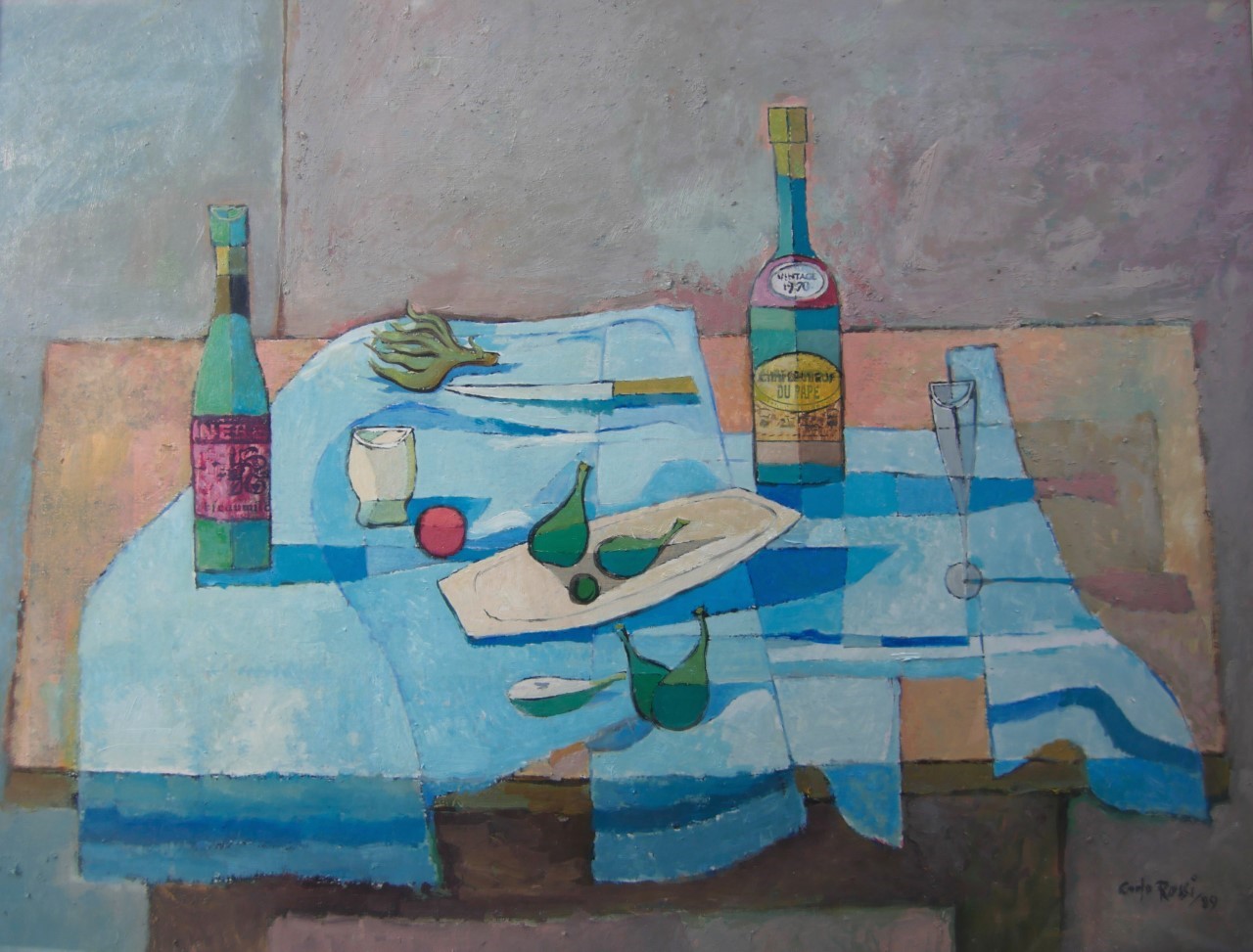
‘Variation on a Theme’ by Carlo Rossi (1921-2010). 1989. Mixed media 55.5 x 68.8 cm. © The Reiff Collection of Modern British Art.
Rossi’s use of blue is innovative in its ability to evoke a sense of place and memory, demonstrating how blue can be both grounding and ethereal. Blue’s dual nature allows it to capture both the tangible and the intangible aspects of memory.
In Conroy Maddox’s ‘Surrealist Figure’, blue creates an atmosphere which almost has materiality or substance to it. The blue feels tangible, almost like ash falling or clouds creeping into the scene, adding a threatening, nightmarish quality. The small size of the work contrasts with the sense of being engulfed by the blue, making it unsettling. The two figures’ stillness against the moving blue background heightens the tension. The blue surrounds and traps the viewer. The viewer may be focusing on the figures, as the blue creeps in unnoticed from behind…
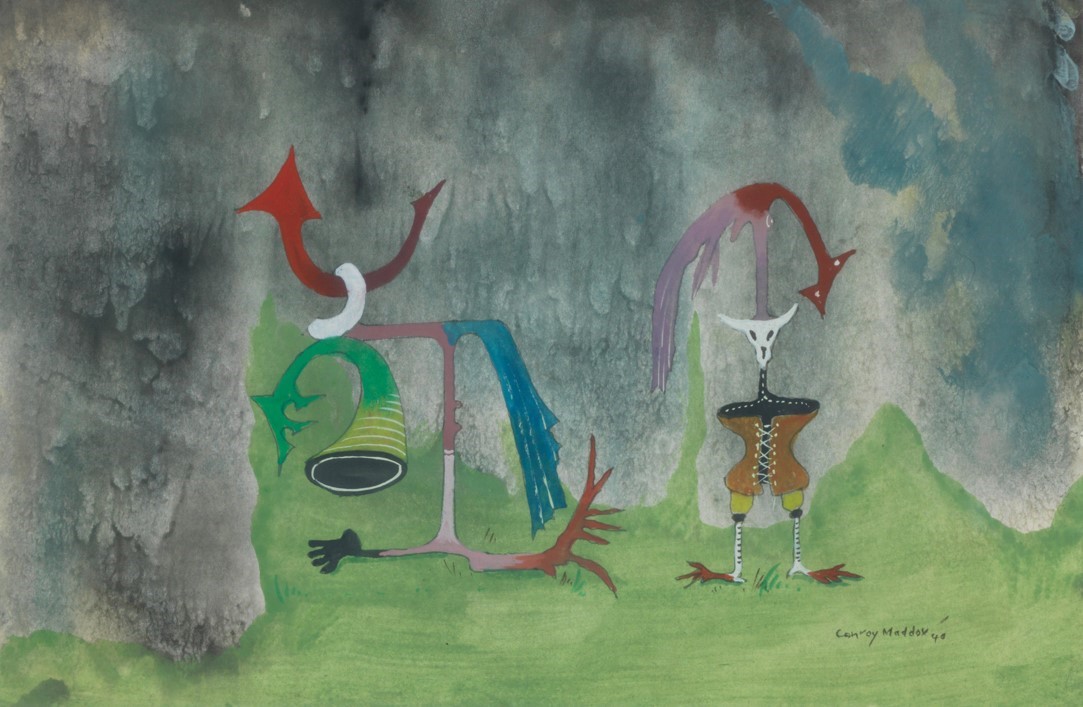
‘Surrealist Figure’ by Conroy Maddox (1912-2005). 1940. Gouache. 25 x 36.5 cm. © The Reiff Collection of Modern British Art.
His use of blue goes beyond traditional representations, making it a dynamic element that interacts with both the figures and the viewer’s perception. Blue conveys emotional and psychological states. The fluidity of blue in Surrealism seems to open a portal to the subconscious mind.
‘Jetty on the Norfolk Coast’ by Hugh Boycott Brown presents a different use of blue, almost realistic. When you think of blue, water often comes to mind. Unlike many maritime works that can be chaotic, this one is very calming. Maritime history in Britain is varied, encompassing war, trade, and local fishing practices. This piece, almost entirely blue, feels peaceful. Despite the deep tones, there’s no sense of malice. It’s a familiar, comforting scene intrinsic to British culture. The cut-off boat on the left implies that the scene continues beyond the frame, suggesting a larger vessel which stands in contrast to the small, local fishing boat we see in full in the centre of the painting.
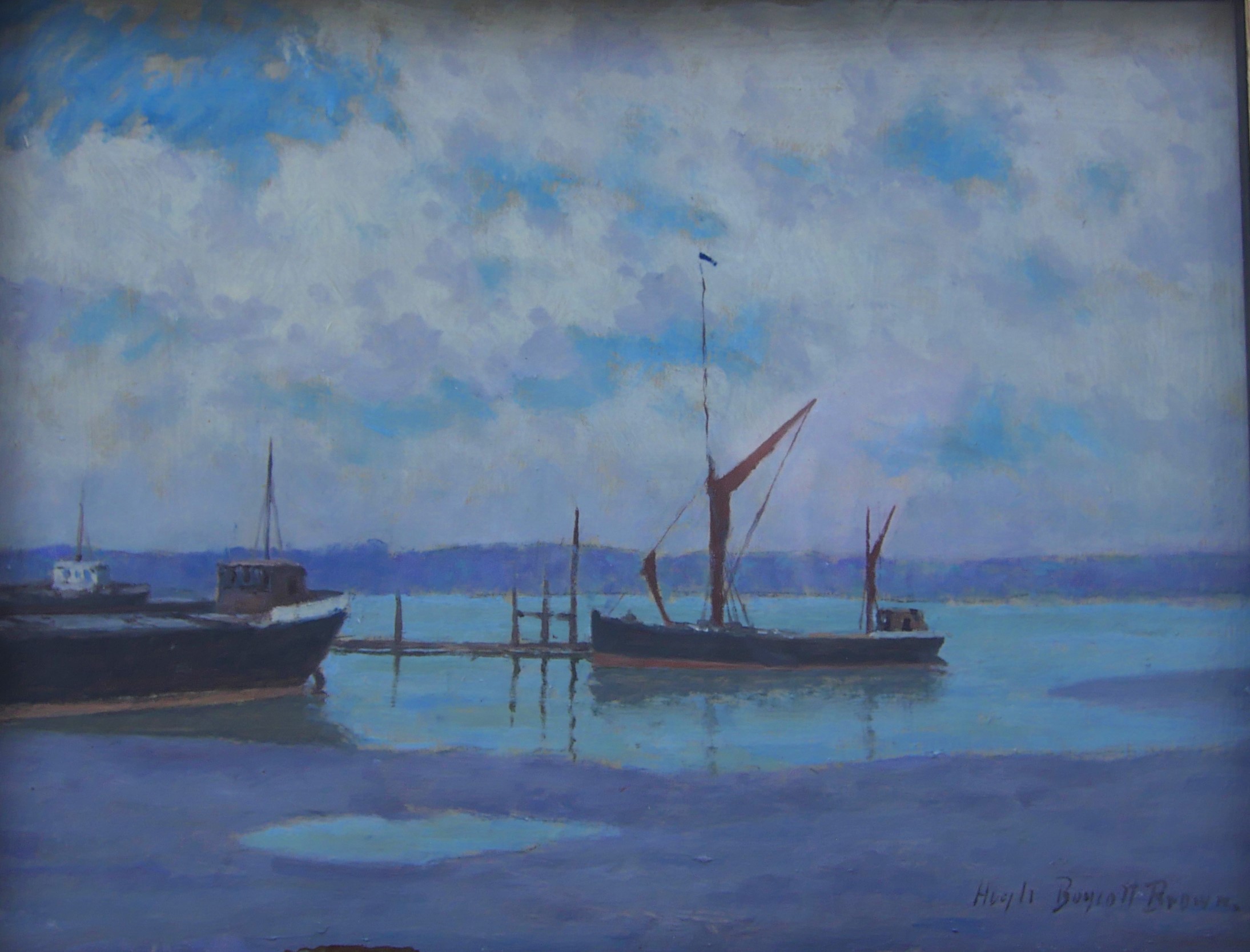
‘Jetty on the Norfolk Coast’ by Hugh Boycott Brown (1909-1990). 39.7 x 47.5 cm. © The Reiff Collection of Modern British Art.
This merging of local and larger-scale maritime elements covers the full spectrum of British maritime history – from small, local fishing to multinational industrial enterprises. It’s a dreamy, idealised depiction of the seaside, blending various seascape experiences into one image.
Symbolism in culture
Blue’s influence extends beyond the canvas, permeating various cultural expressions. In music, the blues genre uses the colour as a metaphor for sadness and longing, encapsulating the resilience of the human spirit. Similarly, in literature, blue often symbolises introspection and the quest for meaning. This multifaceted quality of the colour blue reminds us that, like the colour, we can find beauty and depth in many experiences, embracing calm and contemplation amid life’s hectic pace.
At a glance:
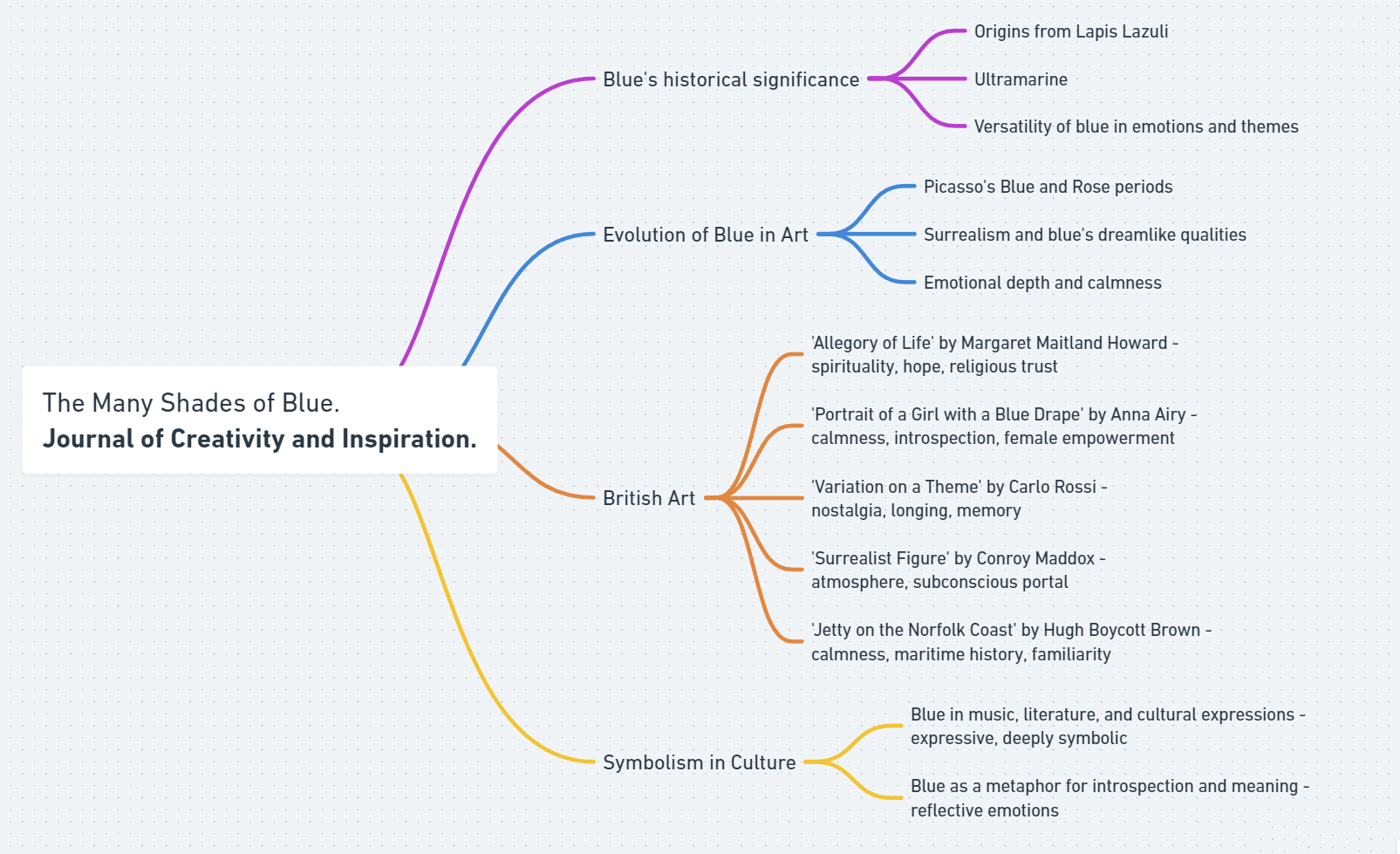
© Journal of Creativity and Inspiration.
Images/arts © The Reiff Collection of Modern British Art. Image: ‘Shades of blue’ by Gil Dekel.
Elle Anderton is a researcher, curator and cataloguer. She recently graduated from The Courtauld Institute of Art, with an MA in collecting, curating and exhibiting modern European art. Elle has previously completed an internship at Philip Mould & Company, curated an exhibition of contemporary art for Durham University, and catalogued the estate of the artist Eric Tucker, known as the ‘secret Lowry’. She is currently working as a Researcher for Katy Hessel, and is also the Collection Assistant for The Reiff Collection of Modern British Art.
Ellie Lachs is a researcher, art collection manager and cataloguer. She has completed an extended internship at Christie’s and also held a position at Frieze, London. She has worked as managing editor and journalist for the arts journal The Flea and is curating an exhibition to be held in London in 2024. She recently graduated from The Courtauld Institute of Art, with an MA in collecting and curating modern European art.
